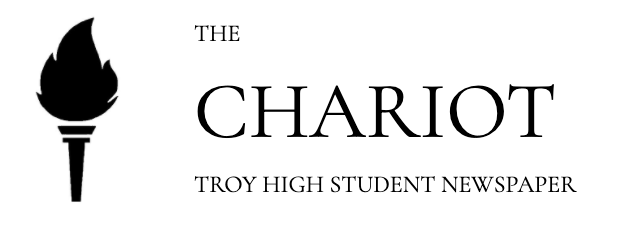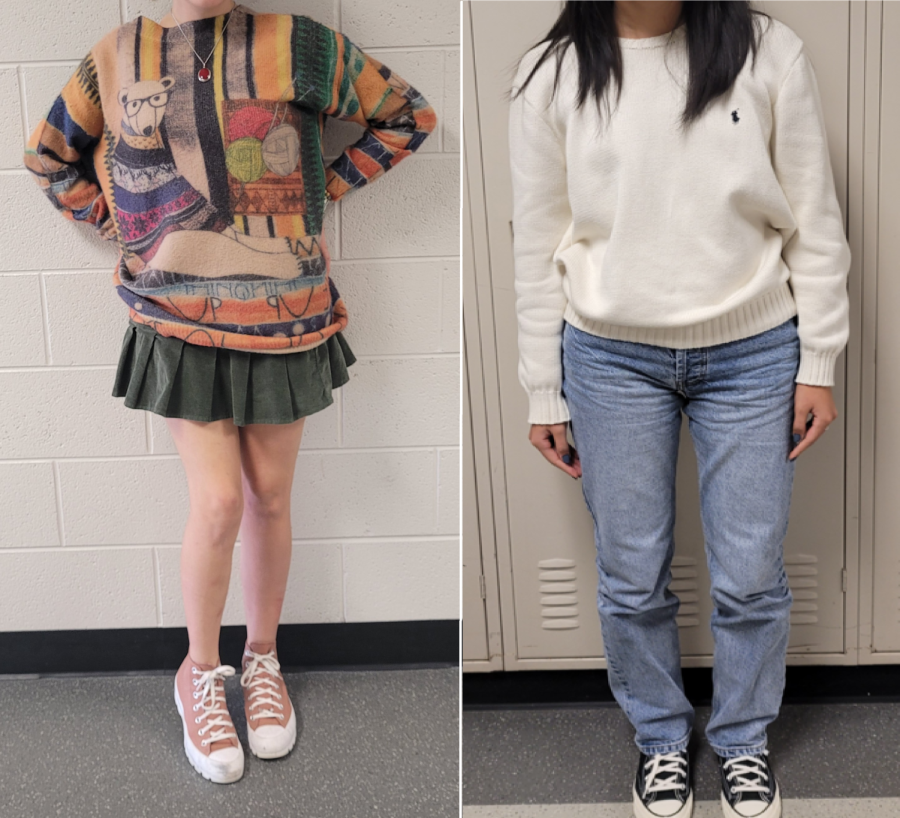Doing Too Much
The shift from minimalism to maximalism.
A maximalist style outfit contrasted with a minimalist style outfit.
Recently, there has been a shift from minimalism to maximalism in fashion. To understand why there has been such a drastic shift in fashion in the past year, having a general definition of minimalism and maximalism is important. Minimalism is defined by simplicity. It normally means people dress in a refined color palette, have more basics than statement pieces and the amount of clothing in their closet is minor.
When asked how she would define minimalism, junior Eredge Najam, who describes her style as so, said, “I would define minimalism as wearing simplistic neutral clothing, and not buying from fast fashion stores, buying from eco-friendly stores, vegan clothing, et cetera.”
People who present minimally often live a more simplistic lifestyle, meaning they are aware of the value of their possessions and intentionally live with fewer. Minimalism is often used to mean fighting the overconsumption of modern day society.
This style first began to appear in fashion in the 1960s, but wasn’t popularized in high fashion until designers such as Yohi Yamamoto and Rei Kawakubo began implementing it into their runway shows. Yamamoto often dressed his models in dark colors, oversized silhouettes and deconstructed clothing. In the 1980s, Kawakubo primarily used black fabric, frayed unfinished edges and asymmetrical hems. Using a singular color and shape for all of their garments created a basic, minimalistic look.
From the 1980s to the early 2000s, the simple living movement grew in popularity, which directly promoted minimalism as a whole. The simple living movement encouraged people to intentionally spend less money, depend less on technology, and limit their possessions.
Minimalist fashion, though not as much the lifestyle, was heavily incorporated by figures like the Kardashians in the mid-to-late 2010s. By 2016, the capsule wardrobe had been popularized, which influenced minimalism as a whole. A capsule wardrobe is a small, curated collection of clothing meant to maximize the amount of interchangeable outfits that can be made.
By 2021, the shift to maximalism had started. Maximalism is inspired by the philosophy that more is better. This style normally consists of colorful patterned outfits, unique silhouettes and lots of layering.
Prior to this, fashion in the 1950s took a turn for maximalism after a few decades of war time. War fashion was constricted due to fabric rations. Once the rations were dissolved, people were able to design bolder styles. This was the first time maximalism came up in fashion. 1950s maximalism consisted of colorful dresses, bold patterns and exaggerated feminine shapes. Inevitably, 1950s maximalism shifted into 1960s minimalism. This shift was triggered by the space age. The space age brought thoughts of the future, which people expected to be sleek and simple.
The opposite shift has been happening recently. This is being caused by COVID-19 and the ever-shortening trend cycle. During the pandemic, the majority of people were quarantined to their homes with the inability to leave, forcing them to live a more basic lifestyle. Many dressed in similar outfits everyday because they were only concerned with practicality. There were also many cuts to salaries over this time period, which caused people to have to be more conscious of their consumption.
After essentially being forced to live a minimalist lifestyle for a year and a half, many were searching for a way to express themselves further. Maximalism was the perfect solution.
Maximalism grew in popularity because of how the trend cycle, or the time in which trends are brought back into popularity, is becoming shorter and shorter. Due to the fact that the trends are coming in and out of fashion at rapid speeds, everything is trendy, which then means nothing is trendy.
The speed in which trends are coming in and out may be due to the amount of time younger generations are spending on social media. Some are updated on everything that is remotely new in fashion, and after they’ve seen it, it’s no longer exciting and they are again ready for whatever is next.
Maximalism fits almost any trend that could quickly come in and out of fashion. Maximalism doesn’t consist of any specific rule set; it’s just an excess of items. This means that almost any item of clothing can be worn as a part of maximalism as long as it’s styled in a way that exemplifies individualism.
Though it can consist of short term trends, maximalism itself is a trend, meaning it inevitably will go out of style. When asked if she thought maximalism had longevity, junior Catherine Sivier, who describes her style as maximalism, said, “No, I do not think maximalism has longevity, I think it’s going to crash and burn.”
Sivier elaborated, saying, “It’s just a fad, and all fads burn eventually.”
One of the major problems that comes with maximalism is the fact that it promotes overconsumption. Maximalism encourages having as much clothing as possible, and it doesn’t specifically promote getting it from ethical sources. When minimalism was popular, thrifting and being aware of your ecological footprint were also popular. Today, there are major examples of overconsumption being popularized, with massive haul videos from fast fashion brands such as Shein and Boohoo being incredibly popular on TikTok and YouTube. Of course, maximalism isn’t the only reason this is happening, but it is certainly contributing to it.
Some aspects of maximalism can be seen positively. It promotes people wanting to express themselves through clothing. However, maximalism is just another trend that will inevitably disappear, but overconsumption caused by maximalism could have effects that affect our Earth forever.
Your donation will support the student journalists of Troy High School - MI. Your contribution will allow us to print our work, purchase equipment and cover our annual website hosting costs.


